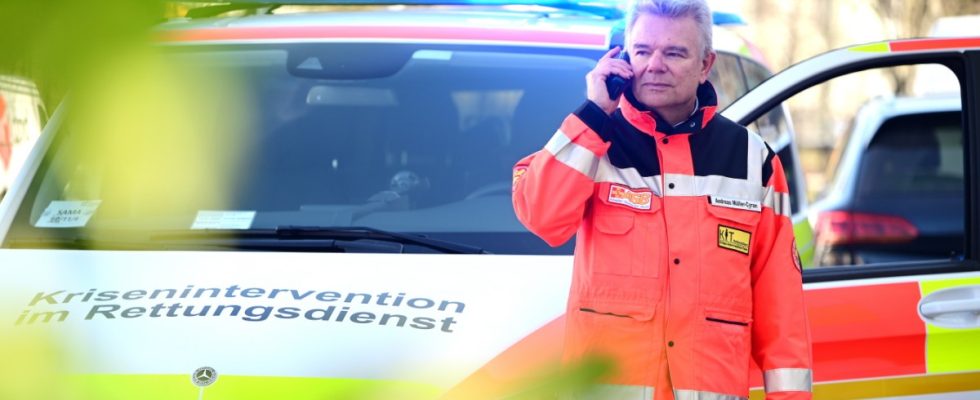What Andreas Müller-Cyran calls the “founding myth of the crisis intervention team” is based on a true incident, a real mission. As a young paramedic, Müller-Cyran was involved in an accident on Landsberger Strasse in 1989. A six-year-old was hit by a tram while crossing the tracks on his bike. The mother stood alone in the middle of the barriers, shopping bags still in her hand, as the emergency doctor had her child lifted into an ambulance and taken to the hospital, with ongoing resuscitation, as they call it. The woman didn’t understand that her boy was already dead.
Müller-Cyran was influenced by the image of the abandoned mother. “We’re trying to save people’s lives with great effort,” he says, “and in the process we’re leaving people behind who have to deal with the impressions for the rest of their lives.”
After this mission, the idea of providing relatives, survivors and those affected by accidents with someone as quickly as possible came to fruition; This is called psychosocial acute help in technical jargon, abbreviated as PSAH. Under the umbrella of the Arbeiter-Samariter-Bund (ASB), Müller-Cyran initiated a crisis intervention team, or KIT for short. It took a few years until work was ready to begin: on March 9, 1994, KIT reported to the rescue control center that it was ready for action and an alert.
The 30th anniversary of the event will not be celebrated until it is warmer. On May 4th, a big anniversary event will take place on Marienplatz. The patron is Mayor Dieter Reiter (SPD), the KIT is a model of success in Munich. It was the first team in the world to be set up to assist physically uninjured but still affected people at the scene of the accident. “The context of operations is always sudden death,” says Müller-Cyran, a studied philosopher, psychologist and theologian. The aim is to help overcome the initial shock: “We are working on the transition from trauma to grief.”
Deployment after the attacks of September 11th and after the tsunami in Thailand
In the meantime, KIT has found imitators, not only in Germany. In the past three decades, the employees of the Munich KIT have been deployed internationally; the Foreign Office has often asked them to look after German nationals in disasters that sometimes left more than hundreds of dead. After the September 11, 2001 attacks in New York and after the Christmas 2004 tsunami in Thailand; after the intentional plane crash in the French Alps in 2015 and after the terrorist attacks in Paris in the same year. And of course, KIT was there for the relatives even after the racially motivated murders in July 2016 at the Olympia shopping center (OEZ) in Munich.
When KIT is reported on, it is always in the context of such spectacular, high-profile events, disasters and homicides. But that’s only a small part of the operations, says Müller-Cyran, “we work close to everyday life.” Most of the time, KIT people respond to heart attacks, strokes, traffic accidents and suicides. In almost three quarters of all cases they come to people’s homes, in their apartments.
July 22, 2016: Even after the racially motivated murders at the Olympia shopping center (OEZ) in Munich, KIT was there for the relatives.
(Photo: Lukas Barth/lukasbarth.com)
One late afternoon this week, Andreas Müller-Cyran is sitting in his office in the Archbishop’s Ordinariate in the city center and swiping on his smartphone: The KIT has already been requested by the rescue control center four times that day, he says, but no use has been made create the news. KIT employees are constantly on the move, on average two to three times a day. More than 24,000 missions have been counted since 1994 and more than 60,000 people have been looked after. “If something happens, it takes the emergency doctor seven minutes to get to the scene, the KIT is there after 20 minutes, with blue lights if necessary,” says Müller-Cyran.
It’s about bringing structure and calm to a chaotic situation
On some missions, the team members are gone again after twenty or thirty minutes and have only taken care of a few things for the relatives. An “initial emotional stabilization so that they can build on something later,” as Müller-Cyran puts it. KIT takes care of other affected people for four or five hours. There is no set schedule for care; it’s about bringing structure and calm to a chaotic situation.
When the KIT employees arrive, there is usually “a great lack of speech,” Müller-Cyran has learned over the years. Breaking the silence isn’t the most important thing, but presence, a “committed form of being there,” as he puts it, “only secondarily what you say.”
The crisis intervention team can currently rely on 61 emergency services, all of whom work purely on a voluntary basis, just like Andreas Müller-Cyran still does. 17 people are currently being trained at a specially designed academy; Interested parties come there from all over the German-speaking region. “This shows that you can do something like this with qualifications on a voluntary basis,” the KIT founder looks back on what he has built.
However, he is concerned with what has not yet been achieved: creating a legal framework for the work of crisis intervention teams. “We are the only rescue service that operates without a legal basis,” he argues about the lack of recognition of politics at the federal and state levels. In Munich we have seen for 30 years that KIT “has a permanent place in the rescue chain”; Here the commitment is also financially supported by the city. In addition, KIT is anchored in the minds of the police and fire departments and is regularly called upon to help. “We are well positioned in Munich,” says Müller-Cyran, “but what does it look like in district xyz?” Too often people are left alone with their suffering.

